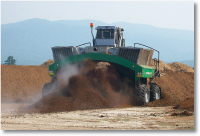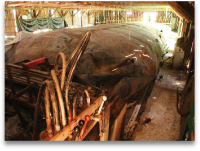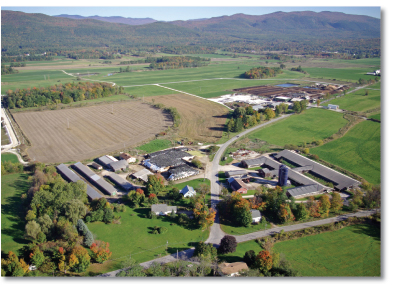
Features
Applications
Beef
Vermont manure digestion pioneers cash in on organic growing
September 4, 2008 by Tony Kryzanowski
Farm businesses pondering what
they want to achieve financially by processing their manure through an
anaerobic digester need look no further than Foster Brothers Dairy to
model their businesses after.
Farm businesses pondering what they want to achieve financially by processing their manure through an anaerobic digester need look no further than Foster Brothers Dairy to model their businesses after.
This fifth-generation dairy, located in Vermont’s Champlain Valley, is definitely old school when it comes to anaerobic digestion of livestock manure, having operated their digester and had the capability to generate power from the captured methane gas since 1982. Today, it’s a proven example that anaerobic digestion is not only good for the environment, but can be extremely profitable as a subsidiary farm business with the right approach.
“It was new for the U.S. agricultural scene but it was an old, old concept that was used on a much smaller scale, particularly in China and India,” says Foster Brothers Dairy co-owner, Robert Foster. “Today, there is a lot more infrastructure to support the industry. Back then, a lot of it was by the seat of your pants.”
 |
| Foster Brothers Dairy – A compost turner processes solids generated from the Foster Brothers Dairy anaerobic digester that will eventually be bagged as organic garden mix and sold to retailers. |
 |
| Foster Brothers Dairy – The flexible cover over the anaerobic digester at the Foster Brothers Dairy is where the methane gas collects. The gas is then transported to another building to scrub out the hydrogen sulfide and moisture before it is burned in a dual fuel engine to generate power. |
Back in the early 1980s, the dairy operated only one of 26 anaerobic digesters in the United States, but sometimes it really pays to be first off the mark. While the methane gas generated from an anaerobic digester is often touted today as the main potential cash cow for a farm business because of its ability to work as an energy source to generate power, Foster Brothers Dairy has cashed in on the composting potential of the separated solids manufactured from the digestion process. The solids generated from the dairy’s digester, combined with separated solids and manure from other farms, are composted on a 10-acre site on the dairy and are the foundation of a well-established organic soil, compost and growing mix business. The dairy owners started this business venture in 1989 on an old barn site.
The organic growing and landscaping products business is managed by a subsidiary of the dairy operation called Vermont Natural Ag Products (VNAP). The compost is mixed with a variety of other materials, like sand and peat, and is marketed under the Moo Doo brand. It is sold through mom-and-pop-type retailers throughout the American Northeast, and to local landscapers. Last year, this subsidiary had nearly $2 million in gross sales, selling 750,000 bags of soil mix and about 10,000 cubic yards of bulk compost. It now has about 1,500 accounts from a business that basically grew through word of mouth. A marketing company now represents their line of products. They also produce a line of private label products sold through a chain of nine stores in the greater Boston area.
Foster Brothers Dairy also manufactures a separate line of compost products, which they do not claim is organic because the sources of raw material to produce the compost can not be verified as organic.
Greater public concern for the environment has definitely impacted positively on the dairy’s composting operation.
“I think there is a greater public awareness of the value of compost,” says Foster, “and that these are organic materials that are being recycled back into the environment. It certainly hasn’t hurt us a bit.”
Foster says there have been occasions, depending on the price for milk, when VNAP has brought in more income to the farm business than milk. It tends to fluctuate depending on the price of milk and input costs to operate the dairy.
While the anaerobic digester and composting operation have certainly helped out financially over the last several years, it wasn’t always a smooth ride. Foster says they have learned some lessons along the way.
Firstly, the manure digestion and composting processes can be integrated but both have to be sized based on the raw material that’s available. Secondly, it is another enterprise that will take time and resources. For example, in addition to the cost of establishing the digestion and composting infrastructure, Foster Brothers Dairy now has 12 people employed in the composting operation alone. It is also important to have someone dedicated to the smooth operation of the digester, and the subsequent composting process, if one exists.
“If you are a dairy, you typically take care of the cows first,” says Foster. “The digester tends to be at the end of the line, so someone has to have the motivation to stay on top of it.”
The dairy farm covers approximately 1,500 acres. Today, there are a number of family members involved in the 380 milk cow operation, which averages production of about 29,000 lbs. of milk annually per cow.
Given the size of the operation, the dairy produces about 12,500 cubic yards of manure annually.
Foster Brothers Dairy hired a small company who had built an Environmental Protection Agency (EPA) demonstration project to install their anaerobic digester. The family had a strong desire to minimize the impact of their dairy operations on the environment.
“I think it is part of the solution to creating a more sustainable society,” says Foster. “We’ve been trying to close loops as close to home as possible and that’s part of why we have gotten involved in this.”
The process starts with manure collection. There are four collection points around the dairy where the manure is pushed over the lip of the barn floor into a waiting wheeled manure spreader. The manure spreader delivers the manure to the digester building, with the longest distance being only about 750 feet.
The manure is then dropped into the reception pit.
Anaerobic digestion is essentially a biological process, where bacteria living in a carefully controlled, oxygen-free and heated environment convert raw manure into methane gas, liquid and solid byproducts over a period of time. Foster Brothers Dairy operates a plug flow system where raw manure is fed into one end and, after about 29 days, it is converted into gas, liquid and solid byproducts.
“We basically use gravity, putting the material in one end and it goes down and comes out the other end,” says Foster. “It’s kind of the first in – first out theory, as opposed to systems where you agitate all the time.”
 |
| Foster Brothers Dairy – Maintaining the beauty of Vermont’s Champlain Valley and good relations with neighbors are two reasons why Foster Brothers Dairy was an early supporter of anaerobic digestion of cow manure. |
The temperature within the digester is maintained at about 95 F. Heat is recovered from a dual fuel engine partially powered by the manufactured methane gas to keep the temperature in the digester steady. Methane gas is manufactured consistently throughout the digestion process and is captured and held as it rises by a flexible cover located over the digester. In a recent development, the cover has been divided into two bags to allow the facility to be used for full-scale research, with one side acting as a control. The gas is transported to a separate building where it is scrubbed through a calcium carbonate filtering system and a water trap to remove hydrogen sulfide and moisture before it is fed as fuel into a Cat 3304 dual fuel engine. It is attached to a 125-kilowatt power generator. The engine operates on both diesel and methane gas, using between 25 to 30 percent diesel to methane under optimum operating conditions.
The dairy did originally have an engine that used methane gas exclusively as a fuel supply. It also initially generated power that it sold to the public utility. However, once the price they were paid for the generated power dropped to five cents per kilowatt hour, which was less than the dairy was paying to purchase power from the state grid to operate the dairy, the Foster family decided to disconnect the generator from the grid and use the power being generated to supply their own dairy farm and three residences.
The solid material exiting the digester has a relatively high moisture content so it is processed through a FAN separator. All liquid generated by the separation unit is conveyed underground to a four million gallon capacity lagoon. Eventually, it is applied on cropland based on their nutrient management plan. The stockpile of largely pathogen-free solids that accumulates from the separator is trucked over to the composting operation located adjacent to the anaerobic digester.
The composing site is designed so it has complete water containment. A separate lagoon was constructed, which captures compost pad leachate. It is used to maintain the 45 percent moisture content needed in the composting process as well as to irrigate cropland. The composting process takes about nine months – three months for the biological composting process to occur and six months to cure so that they are left with a stable product.
The Fosters’ early concern for the impact their dairy was having on the environment has helped to establish a template for other agriculture operations and to demonstrate what is possible by taking this alternative approach to manure management versus land spreading.
The farm business has realized a number of tangible and intangible benefits. For example, it is saving money by not having to purchase power off the grid, although the savings are reduced somewhat by having to purchase diesel fuel. Other benefits include reduced odor in a residential setting, the flexibility to apply nutrients through irrigation on a growing crop, and the availability of separated solids, which others may find beneficial as bedding material in a dairy operation.